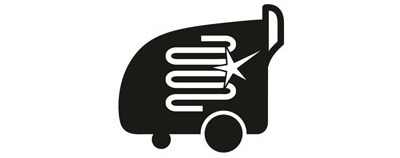Comprehensive cleaning in calf hutches for high biosecurity
Hygiene is an essential part of biosecurity in dairy and beef farming. Correct cleaning processes around the birth and keeping of sensitive calves - from the calving pen to the calf igloo to the calf pen - play a vital role.

A good start in life: calf pen, calf igloo, or calf hutch cleaning
In order for cows to perform well over their lifetime and to ensure high biosecurity on the farm, their environments must be hygienic and clean from the moment the calf is born.
Cleaning a calving pen

Removing large dirt
Before wet cleaning, coarse dirt such as excrement, litter or feed residues should be removed. Sweepers, brooms or shovels are suitable for this purpose.

Cleaning, disinfecting and putting new straw in a calving pen
Like all young animals, newborn calves are very sensitive and must be protected from germs of any kind. To ensure this, the calving pen should not only be mucked out before each new calving and cleaned using hot water with a pressure washer. A measurable reduction in germs can be achieved with thorough work and a water temperature of at least 85 °C. Complete the work with fresh bedding after cleaning and subsequent disinfection.
Tip: Using hot water:
In terms of sustainable management, the hot water from the heat recovery of the milking system can also be used in a cold water unit, as many pressure washers are prepared for a water inlet temperature of up to 85 °C.
Calf hutch cleaning and disinfection
The individual pen of the new calf should also be treated with hot water and additionally with a suitable alkaline cleaning agent. This will minimise calf losses and keep remounting costs under control, such as the cost of restocking when old or sick animals leave. Follow this up with disinfection, regardless of whether it is a calf igloo, calf hutch or calf pen.

Step-by-step:
- Soak the box or calf igloo with water
- Dispense alkaline cleaning agent using a cup foam lance
- Clean and rinse intensively with hot water
- Let everything dry
- Disinfect surfaces
Tip – cleaning the floor around the calf igloo:
Clean the ground around the calf hutches and huts with a hot water pressure washer too. Evidence from research shows that these measures are worthwhile, because the first weeks after birth have an influence on the milk and lifetime performance of the future dairy cows. If the surface is big enough, use a surface cleaner with automatic dirty water extraction, which is connected to the pressure washer. It ensures splash-proof cleaning and drains the service water in a controlled manner.
Cleaning pens with hot water and disinfecting
When the calf moves from an individual pen to group housing, the new environment is initially a challenge for the immune system. This is especially true if the calves come from different farms. Hygiene plays a major role in minimising germ pressure. Before occupancy, the group pen must be thoroughly cleaned with hot water and disinfected. A wet and dry vacuum cleaner can effectively support the work of the high-pressure cleaner to remove dirt and residual water.


Advantages of a hot water pressure washer
Pressure cleaners clean even better when the water is hot and they operate at a constant pressure. In addition to better results and faster cleaning and drying times, you can achieve a measurable reduction in germs when using hot water pressure washers. Steaming helps sensitive surfaces to be cleaned gently at temperatures of up to 155 °C. In addition, the devices make it possible to reduce the working pressure, the time required and the amount of cleaning agents you use. Cleaning with hot water offers several advantages and various possibilities to optimise the cleaning process.
Cleaning equipment
In addition to the complete group pen, it’s important to clean the water supply for the calves and the tools, such as brooms or shovels. Foreign matter from the outside environment introduced into the barn can be reduced by the regular use of a sweeper.
A trio of devices covers all requirements
A basic set of pressure cleaners, sweepers, and wet and dry vacuum cleaners can be used flexibly and serve the cleaning needs of the calf igloos, pens, stalls and implements comprehensively. This ensures that all hygiene measures comply with biosecurity and the health and welfare of calves.











